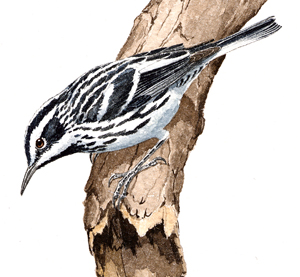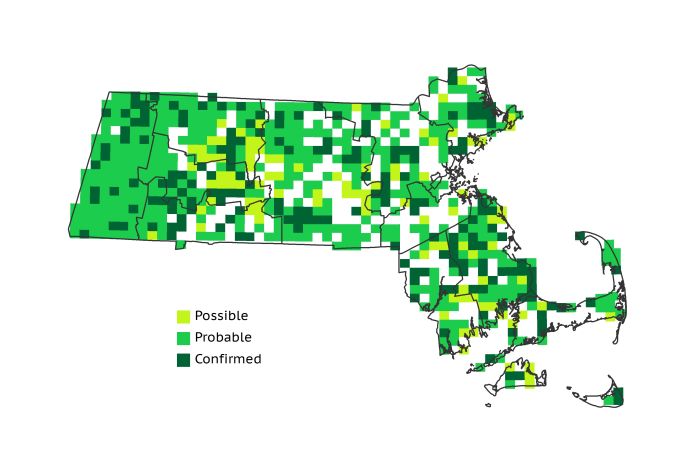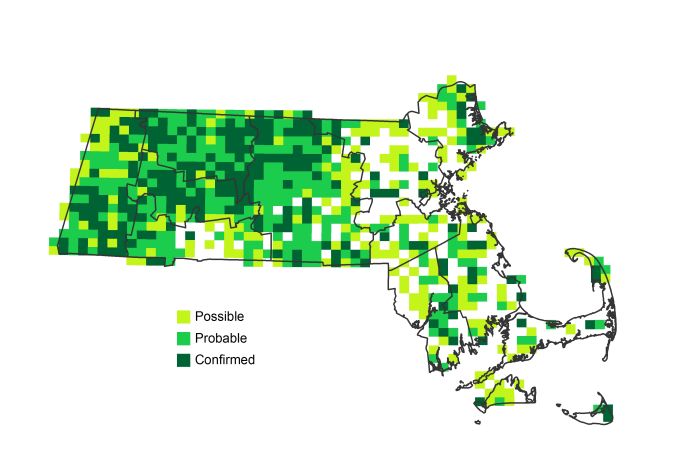Find a Bird
Black-and-white Warbler
Mniotilta varia

Very widespread and likely declining
Action/monitoring needed
“Now it is dusky, / And the hermit thrush and the black and white warbler / Are singing and answering together. / There is sweetness in the tree, / and fireflies are counting the leaves.” Hilda Conkling, “Evening”
Most warblers are in constant motion, hopping from branch to branch in their search for invertebrates to eat, which makes identifying many species by their behavior alone usually quite difficult. The Black-and-white Warbler stands apart from its fellows since it forages by creeping along the bark and larger branches of trees, much like a nuthatch. Although the Black-and-white Warbler remains widespread in Massachusetts, it is beginning to show the first signs of decline.
Historic Status
In the early years of its cohabitation with European settlers in the New World, the Black-and-white Warbler was known as the Black-and-white Creeper, because of its creeper-like way of moving about the large limbs of trees. By the time that Edward Howe Forbush was writing about birds in Massachusetts during the early twentieth century, the species’ name had officially been changed from creeper to warbler (Forbush 1929). As far as its history in Massachusetts goes, that was the extent of the drama. As denizens of deciduous woodlands, Black-and-white Warblers were likely affected by the post-Columbian period of deforestation and reforestation that occurred across the eastern half of the United States.
Atlas 1 Distribution
As with many forest-dwelling birds in a forest-dominated state, block occupancy was high during Atlas 1, reaching 70%. Black-and-white Warblers were quite dense in the western part of the state, where they were widely distributed with few gaps in their footprint. The lowest block occupancy figure west of the Connecticut River Valley was 88% in the Vermont Piedmont, and two western regions had breeding Black-and-white Warblers in every block. The birds were not quite as thick in the more open Connecticut River Valley, but they were still fairly widespread. The higher elevation and more significant forest cover in the Worcester and Lower Worcester Plateaus showed an accompanying rise in warbler concentration, but block occupancy in the suburbanized Coastal Plains was more moderate (63%). The Bristol/Narragansett Lowlands had warblers in over 70% of the blocks, but the Boston Basin and Cape and Islands had birds in fewer than half of the blocks surveyed.
Atlas 2 Distribution and Change
Unfortunately these curious tree-crawling, ground-nesting warblers showed signs of real decline in Atlas 2. In the westernmost parts of the Bay State they were characterized by stable persistence and a nearly unbroken blanket of occupied blocks; they remained all but ubiquitous west of the Connecticut River Valley and in the Worcester Plateau. From the Lower Worcester Plateau eastward, Black-and-white Warbler distribution was characterized by instability and declines in block occupancy. For these declines it is instructional to look at the effort-controlled data. Declines in the east, in particular in the Boston Basin, Bristol/Narragansett Lowlands, and Cape and Islands are steep, and overall the species had a net loss of 6% since Atlas 1.
Atlas 1 Map

Atlas 2 Map

Atlas Change Map

Ecoregion Data
Atlas 1 | Atlas 2 | Change | ||||||
Ecoregion | # Blocks | % Blocks | % of Range | # Blocks | % Blocks | % of Range | Change in # Blocks | Change in % Blocks |
Taconic Mountains | 15 | 93.8 | 2.2 | 24 | 96.0 | 3.4 | 0 | 0.0 |
Marble Valleys/Housatonic Valley | 39 | 100.0 | 5.8 | 38 | 97.4 | 5.4 | -1 | -2.6 |
Berkshire Highlands | 52 | 94.5 | 7.7 | 55 | 100.0 | 7.7 | 2 | 3.8 |
Lower Berkshire Hills | 28 | 100.0 | 4.1 | 30 | 96.8 | 4.2 | 0 | 0.0 |
Vermont Piedmont | 15 | 88.2 | 2.2 | 17 | 100.0 | 2.4 | 0 | 0.0 |
Berkshire Transition | 34 | 89.5 | 5.0 | 40 | 100.0 | 5.6 | 1 | 3.2 |
Connecticut River Valley | 40 | 71.4 | 5.9 | 45 | 69.2 | 6.3 | 2 | 4.2 |
Worcester Plateau | 64 | 82.1 | 9.5 | 87 | 98.9 | 12.3 | 2 | 4.2 |
Lower Worcester Plateau | 56 | 75.7 | 8.3 | 71 | 88.8 | 10.0 | -1 | -1.9 |
S. New England Coastal Plains and Hills | 170 | 63.0 | 25.1 | 181 | 64.0 | 25.5 | -11 | -4.9 |
Boston Basin | 24 | 42.9 | 3.6 | 15 | 26.8 | 2.1 | -9 | -16.4 |
Bristol and Narragansett Lowlands | 77 | 72.6 | 11.4 | 62 | 54.4 | 8.7 | -16 | -15.8 |
Cape Cod and Islands | 62 | 45.6 | 9.2 | 45 | 31.3 | 6.3 | -21 | -17.5 |
Statewide Total | 676 | 69.8 | 100.0 | 710 | 68.5 | 100.0 | -52 | -6.3 |
Notes
The Breeding Bird Survey (BBS) shows significant declines in Black-and-white Warbler abundance for Massachusetts and the New England/Mid-Atlantic Region. This is not a "whispering species"; this species’ declines are borne out by both the Atlas and BBS data. The presence of large numbers of animals such as cats, raccoons, and rats that often wreak havoc on ground-nesting birds is one possible explanation for the disappearance of Black-and-white Warblers from more than a third of all blocks in the thickly settled Boston Basin where these predators are abundant. It is also possible that declines for this species are due, in part, to forest fragmentation increasing the amount of “edge” around forest parcels. With increasing “edge” comes a host of challenges for a forest interior species – increasing nest parasites like Brown-headed Cowbirds and increasing pressure from ground predators.



